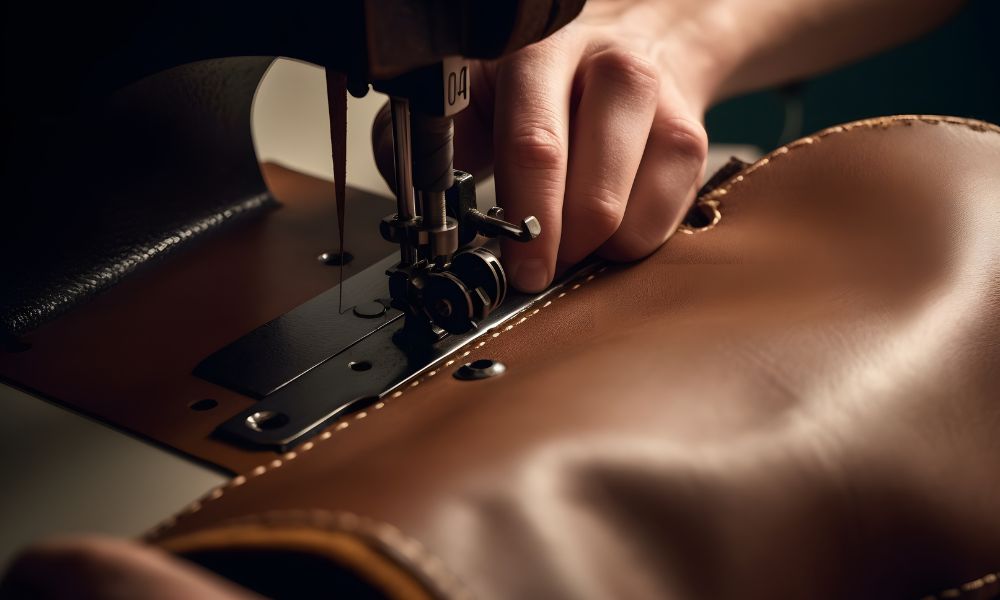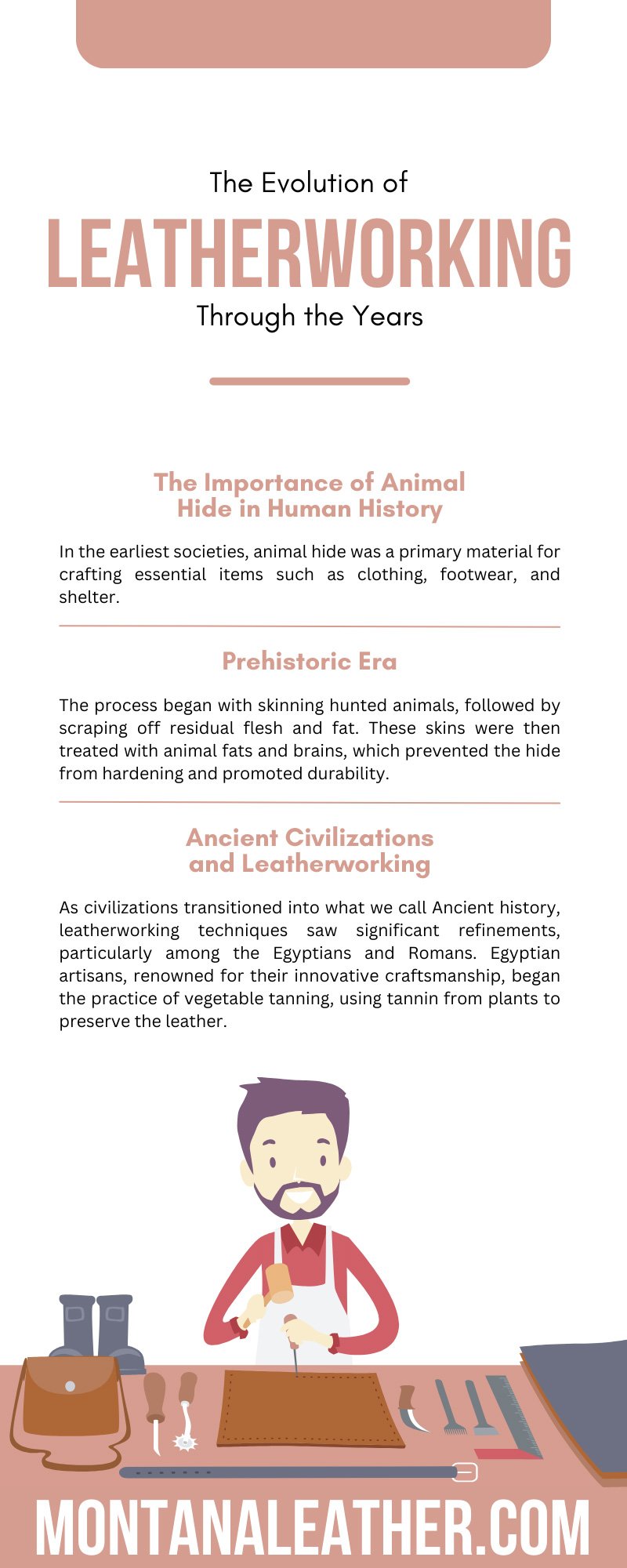
As any leatherwork professional knows, the art and craft of working with leather has experienced many changes. From its humble beginnings as a tool for functionality to an avenue for creative expression, leatherworking has come a long way. Learn more about the evolution of leatherworking through the years and understand the efforts of many leather crafters over the course of centuries.
The Importance of Animal Hide in Human History
Working with animal skins holds immense importance in the evolution of human civilization. In the earliest societies, animal hide was a primary material for crafting essential items such as clothing, footwear, and shelter.
This was not merely a matter of convenience but a survival necessity. The superior durability of hide compared to other available materials made it an invaluable resource in harsh environments.
As civilizations grew more advanced, so too did their mastery of working with animal skin. Ancient cultures elevated the craft to an art form and the tools to make them. Leatherworking gradually grew from a hobby to a profession, with many leathersmiths playing an important role in different eras.
Prehistoric Era
In the Prehistoric Era, the advent of leatherworking marked a significant turning point for early civilizations. The process began with skinning hunted animals, followed by scraping off residual flesh and fat. These skins were then treated with animal fats and brains, which prevented the hide from hardening and promoted durability.
This form of tanning ushered in a new epoch in human survival and technological advancement. With the invention of leather, humans benefited from stronger, more weather-resistant clothing. Hides from large animals provided rudimentary shelter, contributing to humanity’s ability to survive in various climates and geographical landscapes. The prehistoric era represents the dawn of leatherworking, a craft that has evolved over millennia yet still retains the fundamental principles established by our ancestors.
Ancient Civilizations and Leatherworking
As civilizations transitioned into what we call Ancient history, leatherworking techniques saw significant refinements, particularly among the Egyptians and Romans. Egyptian artisans, renowned for their innovative craftsmanship, began the practice of vegetable tanning, using tannin from plants to preserve the leather. This process resulted in more flexible leather, making it ideal for crafting footwear, vessels, and armor.
Meanwhile, the Romans, known for their meticulous attention to detail and quality, developed advanced techniques for tooling and dyeing leather. They used leather extensively, featuring it in durable footwear and protective military gear to high-quality clothing and ornate accessories. Ancient civilizations, through their ingenuity and creativity, elevated the craft of leatherworking, setting the stage for the further evolution of this versatile material in the years to come.
Leatherworking in the Middle Ages
The Middle Ages marked a period where leather evolved from a tool for survival to a medium of artistry, symbolism, and social status. Guilds of tanners, shoemakers, and saddlers emerged across Europe, each dedicated to mastering and advancing the art of leather crafting in their respective fields.
Cowhide leather’s durability, flexibility, and malleability made it the ideal resource for producing diverse goods, including robust horse saddles, hardwearing belts, and even manuscript covers. This period undeniably underlined the superiority of cowhide leather, showcasing its endless applications and firmly establishing its importance in various crafts.
Leather in the Renaissance
Given the setting for enhanced artistry, leather became a valuable material for creative expression. The invention of “Cuir Bouilli,” a pre-Renaissance technique involving boiling leather in wax or oil to harden it, allowed artists to mold leather into intricate shapes and designs. This technique lent itself to creating decorative objects, sculptures, and ornate bookbindings, symbolizing the amalgamation of form and function.
Artisans began experimenting with exotic leathers, such as alligator and snake, and expanding the horizons of the craft. This period was also significant for developing the glove-making craft, with leather gloves symbolizing elegance and nobility.
Industrial Revolution and Leatherworking
With the introduction of steam power and mechanized tools, the production of leather goods shifted from painstaking manual labor to mass manufacturing. For the first time, tanning occurred on a large scale, significantly increasing the availability and affordability of leather products. The invention of the sewing machine revolutionized the footwear industry, making consistent, high-quality leather shoes accessible to a wider market.
With the rise of the railway and automotive industries, leather found new applications in the upholstery of luxurious train cabins and cars, further showcasing its adaptability. Despite the changes in production methods, the craft’s core remained rooted in the age-old principles of quality and durability, underscoring leather’s timeless appeal and versatility.
Leatherworking in the 20th Century
The rise of chrome tanning in the early 1900s, a process faster and more efficient than vegetable tanning, led to an increase in the production of soft, durable leather. Leather became more popular in the automobile, fashion, and aviation industries with the help of chrome tanning.
Leather jackets became a symbol of rebellious cool, epitomized by iconic figures such as Marlon Brando and James Dean. In aviation, leather bomber jackets became synonymous with the bravery of fighter pilots. The fashion industry also seized upon the versatile charm of leather, integrating it into many designs, from haute couture to streetwear.
Modern Leatherworking Techniques
In the 21st Century, computer-aided design (CAD) and laser-cutting tools revolutionized the precision and efficiency of leather crafting, enabling the production of intricate patterns and designs. Innovative tanning processes now incorporate environmentally responsible practices, reducing waste and promoting sustainability.
Leather is now a common material used in various industries, and many continue the work set forth by our ancestors centuries ago. Leatherwork is now a common occupation that creates many work opportunities and enhances universal skills.
Companies sell various kinds of leather hides in large quantities, including wholesale veg tan leather. Technology makes the production and crafting of leather projects easier to complete on a massive scale. As we continue to advance the devices we use, more possibilities in leatherwork will arise.
Sustainable and Ethical Concerns in Leatherworking
In its quest for progress, the leather industry stands at the intersection of environmental sustainability and ethical responsibility. The conventional tanning processes, which often involve heavy reliance on chemicals, pose significant environmental challenges. Simultaneously, the sourcing of hides often raises questions of animal welfare.
As such, the modern era demands a renewed focus on sustainable leatherworking practices. Trends such as modern vegetable tanning and chrome-free alternatives address these concerns, steering the industry toward a greener future. While celebrating its rich heritage and versatility, the leather industry acknowledges these challenges and works to forge a sustainable and ethical path forward.
Future of Leatherworking
As we embark on new frontiers of craftsmanship, the utilization of precision technologies such as CAD and laser cutting will redefine the boundaries of design. The leather industry is ready to further embrace sustainable practices, with eco-friendly tanning methods and ethically sourced materials becoming not just a preference but a necessity. With its timeless appeal and unparalleled versatility, leather will remain prominent in fashion and technology.
Looking back and ahead, it is clear that leatherworking has a history of evolution into a valuable part of civilization. The evolution of leatherworking through the years is a testament to humanity’s ingenuity and resourcefulness. As we look towards the future, we may confidently say that leatherworking will continue to change how we create products with refined quality.

